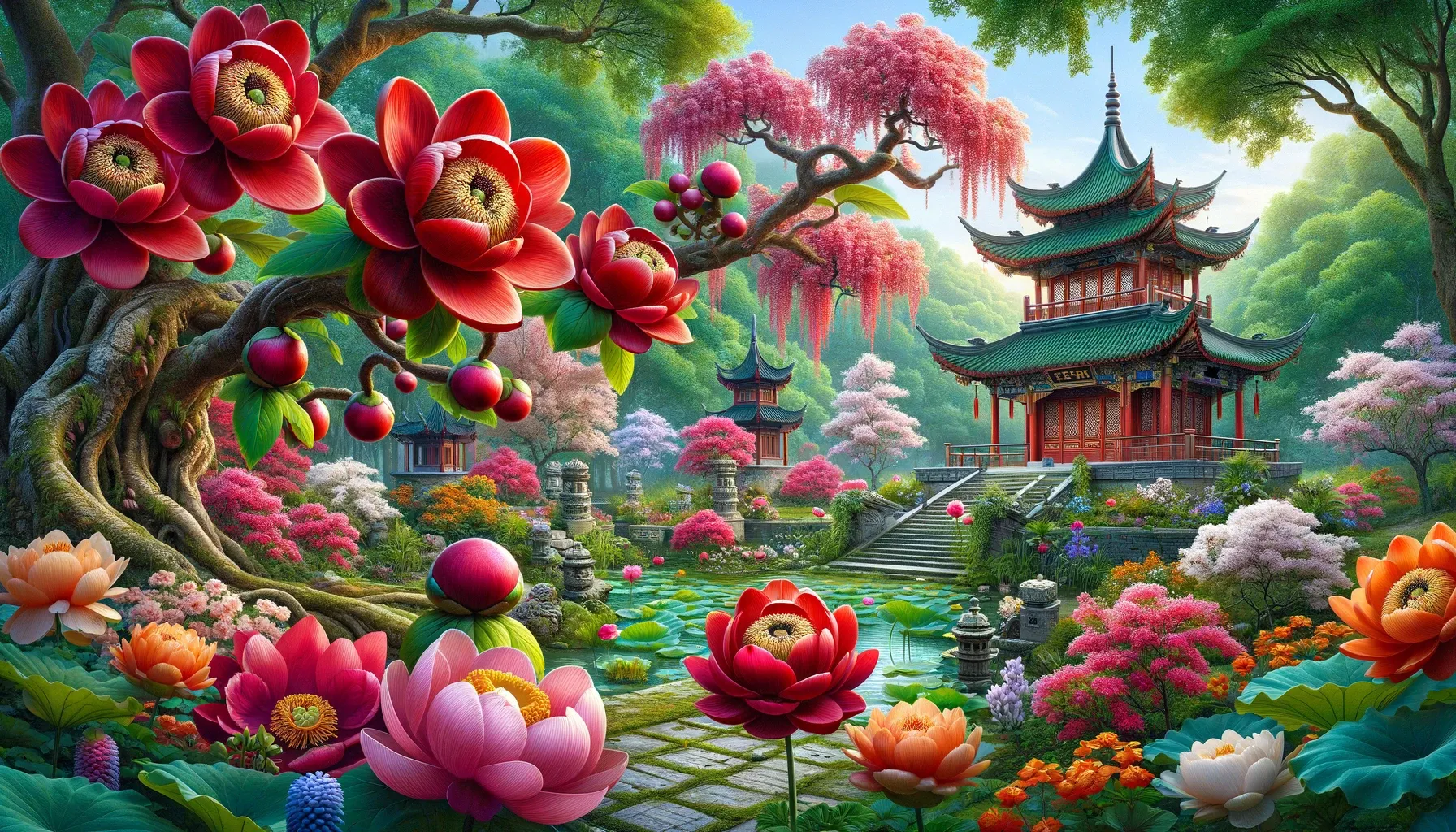The Timeless Beauty of Spring Blossoms in China
Spring in China is a symphony of colors and scents, a time when nature awakens in a grand display of beauty and renewal. Among the most enchanting sights are the blossoms of the Cannonball Tree (Couroupita guianensis). These flowers, though not native to China, have found a beloved place in
Spring in China is a symphony of colors and scents, a time when nature awakens in a grand display of beauty and renewal. Among the most enchanting sights are the blossoms of the Cannonball Tree (Couroupita guianensis). These flowers, though not native to China, have found a beloved place in the country's gardens, where their vibrant blooms and exotic allure captivate all who behold them.
A Journey Through Chinese Gardens
To wander through a Chinese garden in spring is to step into a world where time seems to stand still. These gardens, meticulously designed and lovingly maintained, are a testament to the ancient Chinese art of landscape gardening, where every element is chosen for its beauty and harmony. The Cannonball Tree flowers, with their striking red petals and intricate structure, fit seamlessly into this aesthetic, adding a touch of the extraordinary to the serene landscapes.
In traditional Chinese gardens, the Cannonball Tree flowers bloom in clusters, their large, fragrant blossoms creating a breathtaking spectacle. The flowers feature a central pink and yellow stamen, which stands out vividly against the rich red petals. This striking appearance not only adds to the aesthetic charm of Chinese gardens but also serves as a reminder of nature's intricate artistry.
A Symphony of Colors and Scents
The arrival of spring in China is heralded by a burst of floral beauty. Peonies, cherry blossoms, and lotuses join the Cannonball Tree in a vibrant chorus. Each flower brings its unique charm and significance, creating a tapestry of colors that delight the senses.
Peonies, with their large, lush blooms, symbolize prosperity and honor. They are often referred to as the "king of flowers" in China, revered for their elegance and grace. The cherry blossoms, or sakura, represent the fleeting beauty of life, their delicate petals falling gently to the ground as a reminder of the transient nature of existence. Lotuses, rising from the muddy waters to bloom in pristine beauty, symbolize purity and spiritual awakening.
Amidst these traditional symbols, the Cannonball Tree flowers stand out as a symbol of exotic beauty. Their deep red petals and unique structure are a visual feast, drawing the eye and inspiring wonder. The flowers' rich fragrance adds to the sensory experience, filling the air with a sweet, intoxicating scent that lingers long after the petals have fallen.
A Celebration of Cultural Exchange
The presence of the Cannonball Tree in Chinese gardens is a testament to the country's openness to cultural exchange and appreciation for diverse beauty. Though native to tropical regions of Central and South America, the Cannonball Tree has been embraced in China for its unique aesthetic and adaptability.
In many ways, the story of the Cannonball Tree in China mirrors the broader story of cultural exchange and influence. Throughout its history, China has welcomed and integrated elements from various cultures, enriching its own traditions and creating a vibrant, diverse society. The Cannonball Tree, with its exotic blooms, is a perfect example of this cultural synthesis.
In Chinese gardens, the Cannonball Tree flowers are often planted alongside traditional Chinese plants, creating a harmonious blend of native and exotic species. This juxtaposition highlights the beauty of diversity and the richness that comes from embracing different cultures and traditions.
The Symbolism of Flowers in Chinese Culture
Flowers hold a special place in Chinese culture, where they are often imbued with symbolic meanings. Each flower carries its own significance, representing various virtues, emotions, and aspects of life.
Peonies, for example, are associated with wealth, honor, and feminine beauty. They are often depicted in Chinese art and literature as symbols of prosperity and nobility. Cherry blossoms, with their brief yet beautiful bloom, symbolize the fleeting nature of life and the importance of appreciating the present moment.
Lotuses, which bloom in muddy waters yet emerge clean and pure, symbolize purity, enlightenment, and spiritual awakening. They are often associated with Buddhist and Daoist teachings, representing the journey from the mundane to the divine.
The Cannonball Tree, with its exotic origins and striking appearance, adds a new layer of symbolism to this rich tapestry. Its deep red petals and intricate structure can be seen as symbols of passion, strength, and the beauty of diversity. The flowers' ability to thrive in different climates and settings also speaks to the resilience and adaptability that are valued traits in Chinese culture.
A Timeless Tradition of Garden Design
Chinese gardens are more than just collections of plants; they are carefully designed landscapes that reflect the philosophy, aesthetics, and values of Chinese culture. Every element in a traditional Chinese garden is chosen for its beauty and symbolic significance, from the arrangement of rocks and water features to the selection of plants and flowers.
The inclusion of Cannonball Tree flowers in these gardens is a testament to the gardeners' skill and creativity. These exotic blooms are carefully integrated into the landscape, where they complement and enhance the overall aesthetic. The result is a harmonious blend of native and exotic species, creating a garden that is both beautiful and meaningful.
Walking through a Chinese garden in spring is a sensory experience like no other. The sight of the Cannonball Tree flowers, with their vibrant red petals and intricate design, is a visual delight. The air is filled with the sweet fragrance of blooming flowers, creating a sense of peace and tranquility. The sound of water trickling from a nearby fountain adds to the serene atmosphere, making the garden a perfect place for reflection and meditation.
The Timeless Appeal of Spring Blossoms
Spring blossoms have a timeless appeal that transcends cultures and borders. In China, the arrival of spring is a time of celebration and renewal, marked by the blooming of flowers and the awakening of nature. The Cannonball Tree flowers, with their exotic beauty and rich symbolism, are a perfect addition to this seasonal celebration.
Whether they are admired for their aesthetic beauty, their symbolic significance, or their contribution to the overall harmony of the garden, the Cannonball Tree flowers are a beloved part of the Chinese spring landscape. They remind us of the beauty and diversity of nature, and the ways in which different cultures can enrich and enhance our appreciation of the natural world.
In conclusion, the Cannonball Tree flowers are a magnificent addition to China's array of springtime blossoms. Their striking appearance and exotic charm make them a cherished part of the country's botanical heritage. As we admire these beautiful flowers, we are reminded of the timeless beauty of nature and the enduring appeal of spring blossoms in China.





